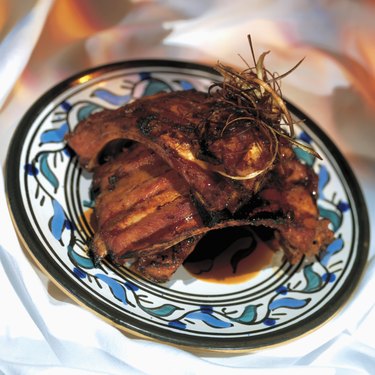
People have cooked succulent meals in terracotta Tuscan ovens since the days of ancient Rome. In these closed clay pots, warm steamy air surrounds the food, cooking it gently without destroying nutrients. The only water needed is the water used to soak the pot before cooking so nutrients and flavors don't get diluted or washed away. Almost any recipe can be cooked in these clay pots but there are a few tricks involved. A caveat: Sometimes the clay used to make terracotta cookware contains lead. For the safest clay pot cooking, buy only from reputable retailers.
Curing the Terracotta
Video of the Day
Terracotta ovens are unglazed and may need curing before cooking in it the first time. Add a handful of rice to a traditional pot of boiling water and cook the rice. Strain to remove the cooked rice; pour the rice water into the Tuscan oven and let it set overnight. Repeat with more rice water until the water runs clear when emptied from the pot.
Video of the Day
Preparing the Oven
Submerge the terracotta oven in water for at least 15 minutes before filling the Tuscan oven with food. Best results come when the porous terracotta is thoroughly saturated.
Cooking
Set the oven temperature to 25 degrees Fahrenheit cooler than the recipe calls for. Allow for longer cooking time, as much as an additional 30 to 60 minutes, depending on the size of the food in the Tuscan oven. Place the terracotta Tuscan oven filled with food in a cool oven. Turn on the kitchen oven to the correct temperature. Check for doneness as the recipe indicates, but be prepared for longer cooking time than when using metal cookware.
Caring for a Terracotta Tuscan Oven
Sudden temperature changes can crack the pot; never set a hot terracotta Tuscan oven directly on a cool surface. Set it on a wire cooling rack or several layers of dishtowel for safest handling. Use only plastic or wooden utensils, as metal can scratch the terracotta.
Cleaning the Oven
Never use soap to clean a terracotta Tuscan oven. The soap seeps into the porous clay and contaminates food the next time the oven is used. Never put a terracotta oven into the dishwasher. Sudden water temperature changes can crack the terracotta, and dishwasher detergent will contaminate it. Use a dry brush or no-scratch scrubbing pad to gently remove food debris. Use a little salt if cooked food particles are especially difficult to remove. Rinse with tepid water and allow the oven to air dry.
Baking Bread
Bread requires dry heat, not the steamy, moist heat suitable for cooking succulent foods. Curing the pot for bread involves a different process than curing it for cooking moist meals, so two Tuscan ovens are necessary if you want to cook both. To use a Tuscan oven for bread baking, liberally coat the inside and outside of the oven with cooking oil. Place the terracotta oven in a cool oven, turn the temperature to 425 degrees F, and keep pot in the oven for an hour. Let the pot cool down gently in the oven. Repeat two or three times until a smooth finish is created; this will allow bread to slip easily out of the Tuscan oven when done.
- Le Cordon Bleu: Clay Pot Cooking; History, Tips and Tricks
- Food Timeline: Bread
- The James Beard Foundation: The Bookshelf; Paula Wolfert’s Mediterranean Clay Pot Cooking
- National Park Service: Timucua Pottery; Making Your Own Pottery
- Penn State University: Medieval Technology and American History; The Bread Oven